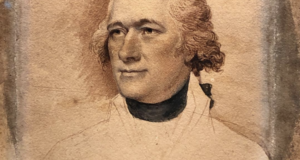Constitutional law and alcohol are forever linked. Many famous distribution of powers cases giving rise to new federalism doctrine were about alcohol. It should not be a surprise that we can now add another case to the list.
R. v. Comeau, coming out of the New Brunswick Provincial Court, is a novel judicial meditation on Canadian federalism, specifically regarding the rarely explored s.121 of the Constitution Act, 1867, which reads as follows:
121. All Articles of the Growth, Produce, or Manufacture of any one of the Provinces shall, from and after the Union, be admitted free into each of the other Provinces.
The Provincial Court, in the process of acquitting an individual from charges laid under a law running afoul of s.121, issued some interesting pronouncements about the nature of Canadian federalism, judicial methods of interpretation, and relationships between constitutional text, structure, and history.
In this piece, I will explore some of these themes. First, it is important to summarize the case and its notable precedent, Gold Seal v. Alberta. Next, I will survey the centerpiece of the Comeau litigation—s.121. S.121 presented an interesting constitutional interpretation choice for the Provincial Court; a choice which, I argue, the Court got right.
It should be noted that, to the extent that it might be perceived that I attack the conclusions of the Court in Comeau, I am supportive of the general methodology which the Court employed. Canadian constitutional law, as of late, has fallen into an undisciplined legal vacuum. This is especially true in relation to the distribution of powers. There is excessive recourse, nowadays, to terms like “living trees,” “progressive interpretation,” “large and liberal interpretation,” and “the modern tide,” in the elucidation of constitutional texts. These are not substantive doctrines nor proper tools of interpretation. On the other hand, Comeau represents an attempt to synthesize federalism doctrine, Confederation history, and textual interpretation with a view to real doctrinal analysis. It is an invitation to the Supreme Court, if it hears this case, to do the same.
PART I—SUMMARY
Comeau is a New Brunswick resident, residing in Campbellton, NB. Campbellton is located close to the border of New Brunswick and Quebec. Comeau would regularly travel to Quebec to take advantage of cheaper alcohol prices; buying beer in Quebec and transporting it over the border back to Campbellton. On one fateful day, Comeau went to Quebec to purchase alcohol. When he made the trip across the bridge back into New Brunswick, he was charged under provisions of the New Brunswick Liquor Control Act. The provisions in question prohibit New Brunswick residents from importing alcohol from another jurisdiction in excess of a 12 pint limit for beer; for spirits, the limit is two bottles. Comeau transported 14 cases of beer and three bottles of liquor, in excess of the regulatory threshold, and was charged accordingly. Comeau challenged these regulations under s.121 of the Constitution Act, 1867, which, as noted above, appears to guarantee the free flow of goods across provincial boundaries.
Comeau was not the first to run into s.121, and at first glance, should have been troubled by the history of the provision. It had been surveyed in an older case, Gold Seal. In that case, Gold Seal, a liquor merchant in Calgary, requested that Dominion Express transport liquor outside of Gold Seal’s province of operation (Alberta) to waiting customers outside the provincial boundaries. Dominion Express refused to conduct the deliveries, on the grounds that the Canada Temperance Act (“CTA”), which had ostensibly been proclaimed into force in Alberta, prohibited the transport of liquor across provincial borders into Saskatchewan and Manitoba. But a problem existed: contrary to existing law, the federal Cabinet had failed to indicate the day on which the CTA would come into force in Alberta. Parliament subsequently passed the Proclamation Validity Act, retroactively affirming all proclamations under the CTA. The key question was whether the CTA had been properly proclaimed, so as to prevent Gold Seal from conducting its interprovincial trade. Notably, Gold Seal only raised s.121 in oral argument. In the result, the Supreme Court of Canada concluded that the CTA was validly proclaimed, and that s.121 did not render the CTA unconstitutional. Justice Duff reasoned that “…the real object of the clause [s.121] is to prohibit the establishment of customs duties affecting interprovincial trade in the products of any province of the Union.” As such, Gold Seal put a restrictive scope on s.121, concluding that s.121 deals only with prohibiting interprovincial barriers in the form of customs duties on items of growth, produce, or manufacture. In other words, “admitted free” under Gold Seal meant “admitted free of customs duties.” If Gold Seal was controlling, the result in Comeau should have been a foregone conclusion.
Conversely, in Comeau, the New Brunswick Provincial Court ruled that s.121 prohibited regulatory schemes such as the one enacted by New Brunswick, and held that the Gold Seal Court had reached the wrong conclusion. In his judgment, Justice Ronald Leblanc dismissed all charges against Comeau (but was unable to strike down the law because the case came before the provincial court). He reasoned that the Fathers of Confederation, in their deliberations prior to the enactment of the 1867 Act, had preferred free trade applied to all products between the provinces. He did not limit this conclusion to customs duties or duties more generally; instead, he concluded that “free trade” was the goal of s.121, which would encompass statutory regulations of any sort. In reaching this conclusion, Justice Leblanc engaged with important questions of constitutional interpretation and federalism doctrine.
PART II—THE CHOICE BETWEEN LIVING TREES AND HISTORICAL ROOTS
Engaging with s.121 necessarily involved a preliminary choice on the part of Justice Leblanc. That choice was between constitutional interpretive mechanisms: a living tree approach, which views s.121 in light of its modern regulatory context, or a review of the history of s.121 to determine its original meaning. The choice was at the centre of the litigation, because the defence argued that s.121 was originally conceived as a way to achieve free trade among the provinces, thus precluding schemes like the New Brunswick Act. The prosecution, however, argued that a living tree approach supported its modern regulatory scheme, which it asserted was the product of “cooperative federalism.” This argument was tied to the assertion that, in the Canadian federation, provinces should be able to enact laws in relation to their own local needs and sensibilities.
It is far from clear that a living tree approach would have favoured the prosecution. The living tree interpretation could, just as reasonably, support the defence’s theory of the case which posited that the modern need for the free flow of goods across provincial borders was impaired by the impugned law. Indeed, the living tree is typically employed to expand rights and broaden interpretations, which in this case would favour the defence’s construction of s.121. In any event, Justice Leblanc clearly found the historical approach more convincing. In reasoning from the original intent of the Fathers of Confederation in enacting s.121, Justice Leblanc concluded:
I find that the speeches and orations from the Fathers of Confederation prior to the enactment of the British North America Act, 1867, conclusively point to their desire to implement free trade as opposed to the elimination of customs duties as between the provinces.
With one fell swoop, Justice Leblanc did away with the Gold Seal interpretation. More importantly, he cut the branches off the living tree of Canadian constitutionalism while admittedly paying lip service to the concept, at least in theory. Of course, the Supreme Court of Canada often relies on Lord Sankey’s famous metaphor to found a form of interpretation which pays heed to the current times and current societal mores—whatever those might be. Under the living tree approach, one must not be bound by text, original purpose, or original understanding. The living tree approach has, as former Chief Justice of the U.S. Supreme Court, William Rehnquist, noted, “a teasing imprecision.” Everyone likes the idea, in theory, of a living rather than dead Constitution. But those same people are unlikely to articulate what guides a living tree interpretive process. Living tree constitutionalism essentially amounts to interpretation by slogan rather than by serious doctrine.
The living tree approach reasons from political arguments—that the law should justify the modern needs of a particular society (or not, if one adopts the prosecution’s argument). Justice Leblanc, however, reasoned from sound principles of legal interpretation. He concluded that the living tree approach must be subordinated to the historical, legal context of the text at issue. He noted that judicial interpretation should not “overshoot” the actual legal purpose of a constitutional text—reflecting Chief Justice Dickson’s comments in Big M Drug Mart. As such, Justice Leblanc noted that:
The original purpose of the provision at issue, therefore, is an important consideration in approaching judicial interpretation of the Constitution. Courts should not allow such elemental and fundamental considerations to be displaced merely by notions of what, today, may amount to a request for accommodation based on a long-standing misinterpretation of the intent of the Fathers of Confederation.
In this way, Justice Leblanc was more concerned about understanding how the Fathers of Confederation conceived of s.121. In short, the original purpose of s.121 was, in Justice Leblanc’s view, designed to achieve free trade in the federation, across provincial boundaries. The assertion that the modern liquor regulatory scheme in New Brunswick might be sustained by recourse to a living tree approach did not stand up to legal scrutiny. As such, that original purpose should be applied to modern fact scenarios and modern sensibilities should not override the fundamental purpose. In this way, Justice Leblanc demonstrated a proper understanding of the function of history in constitutional interpretation, as well as the Constitution Act, 1867 It is a decision which should be lauded for its adherence to proper constitutional doctrine.
Having made the choice for an originalist methodology, it should be asked: what conclusion follows?
PART III—ORIGINAL INTENT AND ORIGINAL MEANING
Justice Leblanc, in exploring the constitutionality of the impugned provision, relied on originalism in two of its manifestations: original intent and original meaning. Original intent purports to interpret the meaning of constitutional provisions in concert with the intent of the framers who drafted the provision. Original meaning does not focus on the intent of the framers. Instead, it focuses on the textual meaning of the words of the provision, as they would have been publicly understood at the time of enactment. Most of those who today fall in the originalism camp consider themselves adherents to original meaning. That makes Justice Leblanc’s reliance on both schools of originalism all the more interesting
The Intent
In ascertaining the intent of the framers, Justice Leblanc first considered statements from some of those associated with the Confederation project, including John A. MacDonald, George Brown, and Georges-Etienne Cartier—all of which endorsed Confederation in part for the economic advantage of free trade. This allowed Justice Leblanc to found a conclusion that s.121 was aimed towards free trade.
Again, this form of interpretation has historically been an oddity in Canadian constitutional law (though it was arguably on full display in the 2014 Senate Reference). In this case, it was used by Justice Leblanc to great effect. There can be little doubt that the Fathers of Confederation intended for Canada to enjoy free trade among the provinces.
The Textual Meaning
Justice Leblanc also considered the specific text of s.121. As he noted, the “plain reading” of “admitted free” did not mean “admitted free of customs duties.” This particular choice of words was not accidental, according to Justice Leblanc. That choice was designed to support the ideas and principles in connection with the original Confederation project. The difference between “admitted free” and “admitted free of customs duties,” was something known to the Fathers of Confederation, and, as such, their use of the former must have been intentional. The fact that the term “duties” appears in other proximate sections of the Constitution Act, 1867, and not in s.121, supported this conclusion.
There are, admittedly, alternative arguments based on constitutional structure which might run up against Justice Leblanc’s interpretation of s.121. Importantly, as the prosecution argued, s.121 is not placed within the Part of the Constitution Act, 1867 which distributes legislative powers. Instead, it is included in Part VIII of the Constitution Act, 1867 which deals with “Revenues, Debts, Assets, and Taxation.” As such, so the argument goes, it was not meant to erect any sort of limitation or definition on a province’s ability to legislate trade barriers akin to the New Brunswick Liquor Control Act. Justice Leblanc did not find this particular placement definitive in reaching his constitutional conclusion. In this regard, he differed from the Gold Seal court, which found the placement factor relevant.
In addition, Justice Leblanc did not consider an alternative argument related to constitutional structure—the relationship of s.121 to s 91 and 92 of the Constitution Act, 1867. Those sections exhaustively distribute legislative power as between Parliament and the provincial legislatures. Specifically, the preface to s.91 in particular reads as follows:
- It shall be lawful for the Queen, by and with the Advice and Consent of the Senate and House of Commons, to make Laws for the Peace, Order, and good Government of Canada, in relation to all Matters not coming within the Classes of Subjects by this Act assigned exclusively to the Legislatures of the Provinces; and for greater Certainty, but not so as to restrict the Generality of the foregoing Terms of this Section, it is hereby declared that (notwithstanding anything in this Act) the exclusive Legislative Authority of the Parliament of Canada extends to all Matters coming within the Classes of Subjects next hereinafter enumerated; that is to say[…] [my emphasis].
The non obstante clause present in this section means, simply, that Parliament is able to legislate in relation to trade and commerce (including interprovincial trade and commerce), notwithstanding anything in the Constitution Act, 1867 which might say otherwise. Thus, if Parliament were to enact a law (as they did in Gold Seal) that undermined so-called “free trade” between the provinces, there would arguably be no constitutional problem. That is because with respect to trade and commerce, so long as Parliament stays within its jurisdictional boundaries, their actions are constitutional, even if s.121 says otherwise. Of course, especially in the modern era, the trade and commerce power is woefully under-explored. As such, it is unclear in practical terms how expansive Parliament’s power to regulate interprovincial trade and commerce truly is. But, one would have a difficult time imagining a situation in which Parliament could not exercise a power to regulate “interprovincial trade and commerce” without running afoul of s.121. Perhaps it is the case that s.121 would only prohibit a federal law that placed a complete ban upon interprovincial trade. Either way, this is a doctrinal riddle which may be addressed by future courts.
In sum, the constitutional text and structure arguably pull in different directions. The plain reading certainly supports Justice Leblanc’s view, as does the immediate context of the nearby provisions of the Constitution Act, 1867. That said, it is arguable that the other contextual considerations go the other way, namely the placement of s.121 in the part of the Constitution Act, 1867 dealing with revenues and the non-obstante clause. Overall, however, when we synthesize the clear intent of the framers with the language they used, the most plausible interpretation is the simple one: s.121 means what it says.
PART IV—STARE DECISIS
Before concluding, it is important to explore a consequence of Justice Leblanc’s reasoning in Comeau. Applying an originalist interpretation to s.121 necessarily involved an explicit choice to not follow the binding Supreme Court decision of Gold Seal. In this sense, this case raises an important problem which is worth exploring: the tension which sometimes arises between originalist interpretation and stare decisis.
Justice Scalia was known to say that he was “an originalist, not a nut.” He argued that originalism, used properly to arrive at legally defensible constitutional interpretations, cannot be permitted to overturn every decided precedent, even in cases where the precedent is clearly wrong as a matter of law. Counterbalancing this argument from predictability is the obvious: judicial interpretation of constitutional law should be based on a defensible interpretive methodology, not slogans. In sum, the battle is between predictability and correctness in law.
It is beyond the scope of this piece to delve deeply into this interpretive conundrum. Needless to say, the overall theme of Comeau seems to be this very contest between predictability and correctness. If one assumes that Comeau is a correct result, one could conclude that Gold Seal should be overturned. On the other hand, one could conclude that Gold Seal is distinguishable because it concerned a federal law, whereas Comeau concerned a provincial law. Yet, this still leaves the fundamental problem unaddressed—what is the proper interpretation of s.121? Does it vary based on the object of the constitutional challenge and the context in which it is brought? These are all questions which have to be left for another court, another day.
PART V—CONCLUSION
Federalism is usually regarded as old, unhip, square—particularly compared to the Charter. But Comeau should be welcomed because it demonstrates the importance of federalism in the modern day. It explores some important and relatively unexplored questions regarding Canada’s federal structure. Justice Leblanc helpfully uses history to ascertain the scope and purpose of s.121, a welcome step in the right direction compared to the Supreme Court’s reliance on clever metaphorical turns of phrase, or as Justice Scalia liked to call them, “mystical aphorisms of the fortune cookie.”
Whether from the perspective of stare decisis or overall constitutional structure, s.121 is a difficult legal question. While Justice Leblanc’s conclusion on s.121 makes sense, and is constitutionally justifiable, there are equally persuasive arguments to suggest that his interpretation has logical limitations—particularly with reference to federal jurisdiction over trade and commerce. As such, one could conclude that s.121 is still an unresolved, open question, which is amenable to resolution by an appellate court. At the same time, the method by which Justice Leblanc reached his conclusion is one which observers of federalism jurisprudence should celebrate.
One hopes that the Supreme Court’s analysis, whatever result it ultimately reaches, will be as seriously doctrinal.
 Advocates for the Rule of Law
Advocates for the Rule of Law




One comment
Pingback: A Marriage Made in Britain: Section 121 and the Division of Powers | Advocates for the Rule of Law